|
In January of 2006, I was reading the local weekly paper when an ad caught my eye. The Peninsula Women’s Chorus was holding auditions. The ad mentioned that they still had spaces available for their upcoming tour to Hungary. I had been thinking about going back to singing after a ten-year hiatus. And I’d never been overseas. So I decided to audition. I was pretty nervous (and rusty). I hunted around till I found the music for a spiritual I’d prepared with my voice teacher back when I last had taken lessons and then practiced furiously until the audition. Because I missed the official audition day, the director asked me to audition after a rehearsal. “Come a little early,” he said, “and you can get a feel for the group.” So, there I was, about 9:30 at night, hoping to slip unobtrusively into the rehearsal. Since the door opened at the front of the room, though, all 50 women watched me enter. Some friendly second sopranos motioned me over, and I ended up looking on as the chorus sang “EI grito” (The Scream) from Finnish composer Einojuhani Rautavaar’s Suite de Lorca. I’m linking to another group’s recording, but as you can guess from the title, the first sound is a musical rendering of a scream. I’m sunk, I thought. This is the best sight-reading chorus I’ve ever seen. I didn’t know many of them had sung the piece before, and thought they were singing it cold. Under those conditions, I was doubly nervous to audition, and doubly surprised when I passed. I didn’t end up singing in their section, but I’ve always remembered the kindness of those second sopranos. I remember Robin, because she shared her stand with me, but as Bonnie usually sat next to her I was likely between the two. 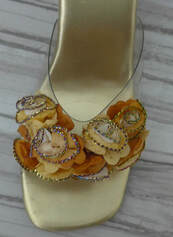 After I'd sung with PWC a few years, a group of women from the chorus asked me if I wanted to join another, smaller group they were in, the JewelTones. Bonnie, one of the second sopranos, was the costumer for that group, which wore 20’s, 40’s and 50’s outfits. A major fringe benefit of singing with the JewelTones was that Bonnie, who loved to haunt thrift stores, would pick up non-costume items that she thought the other singers would like. She gave me some great shoes (flowered platforms, leopard print rain boots, rhinestone Cinderella shoes), and hats. Several hats. These hats were not for costumes, but for me to wear for fun. Today’s post features two of them: the green and purple knit hat and the collapsible purple hat (it cleverly stores completely flat). The green hat has been in the winter hat rotation, and I’ve worn the purple hat to church, the park, and, sentimentally, to rehearsal with the chorus I have sung with since I moved away from the Bay Area and PWC.
6 Comments
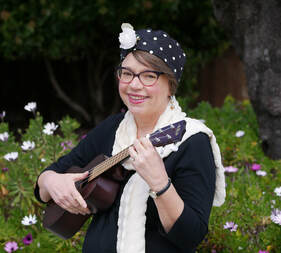 This week I wore another hat that I’ve never worn before, but this time more than timidity kept me from wearing it. I bought this hat at an outdoor art fair on a warm summer day. I got the feeling that the young lady selling the hats hadn't been at it long. “Do you have a bag for it?” I asked. She looked puzzled, regretful, as if she’d never considered that someone might want a bag (note—this hat dates from the days when all retail establishments and art fair vendors gave out bags). So I took the hat without a bag. My husband offered to go into a nearby store and see if he could buy one, but I said, “No, that’s OK.” Big mistake. As we walked through the art fair, my hands got sweaty. I held the hat gingerly at the back, but when we got home, I noticed that my sweaty palms had discolored the back of the hat. I was upset with myself for not just getting a bag from somewhere, anywhere, and upset at the hat seller for being so unprepared. I wasn’t sure if the hat was made from a washable material—from the way it discolored as I held it, I doubted it. It might even be of acetate. Once I tried to wash an acetate dress and it turned into a stiff shriveled lump. Honestly, I knew the stain wasn’t too bad. But it was noticeable, and it was a brand new hat, dammit! So I put it in a box. Looking for a different hat I thought I might wear, I opened the box and found this one in there too. I still liked it. And though I knew the hat was discolored, it was no more discolored than some of my vintage hats, to be honest. So I decided to wear it. This hat initially attracted me because it reminded me of the hats worn by members of my favorite swing trio, Cats & Jammers (sadly, now defunct, though you can still buy their recordings). I decided to wear it to church on a Sunday I was singing with the choir in front of the congregation. That way, I would both honor the musical inspiration for buying the hat and, since no one would be sitting behind me, hide the discolored back. After the service someone said I was “rocking” the hat. I thought that was an appropriate term. I can’t play guitar or bass fiddle, like the women in Cats & Jammers, so posing with my ukulele was as close as I could get. Brightly lit picture showing the discoloration that I hope isn't too noticeable in dimmer lighting.
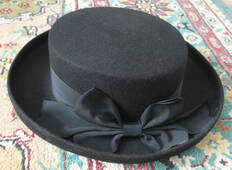 I have so many hat boxes, most with multiple hats in them, that when I want a hat, I have to go looking for it. In searching for the green feathered hat, I opened a box to find one lone black hat resting inside. Usually, when I come upon a hat, I think “Oh, right, that one.” But I had no memory of this hat. Not of buying it, or being given it, or wearing it. The box was from the 90’s, so the hat might date from that decade too. Looking more closely, I sort of recognized the ribbon around the brim. Really, it’s a nice bow. A quality hat—made by the Bollman Hat Company, the oldest hatmaker in the US. Since it’s black on black, though, no burst of color makes it memorable. Also, the hat seems vaguely Western—as if it could be worn by a saloon gambler. A few years ago, I moved from an urban area to a semi-rural town where you might see a woman in the Rite-Aid wearing a cowboy hat, boots, and turquoise jewelry. Though the town attracts wine tourists, it also has a cow-town vibe, in its livestock at the mid-state fair, it’s annual tractor parade, and its plethora of “Eat beef. The West wasn’t won on salad” bumper stickers. I haven’t eaten beef in over 20 years. I can’t pretend to be anything but a city slicker, and shouldn't even try. Cow mural downtown. 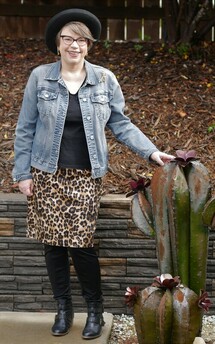 So: A Western-style black hat with a black ribbon? What was I thinking? Here’s what I speculate happened. One day, on a department store clearance table, I came upon this hat. Though it didn’t call to me, it was probably a bargain. And looking at its basic black color scheme, I probably thought, “This hat will be so practical! I can wear it with anything!” and bought it. Well, from my previous post, you know that I eventually learned to steer clear of the merely practical. If an article of clothing doesn’t appeal to my sense of fun and style, it sits in the drawer or box, unworn. Forgotten. So I took this hat out, brushed it with my lint brush, and wore it. I didn’t feel like I was wearing anything unusual, or magical. It wasn’t the ruby slippers. It was just a hat that didn’t seem “me.” When I wore it to church, someone said, "I love your hats! Especially the one you wore last week, with the feathers." I wasn't alone in finding this hat forgettable. Here's my city-slicker outfit, including a leopard-print skirt and boots from Macy’s, not the local Boot Barn. When I started this project, I told myself that I would donate any hat that I didn’t want after wearing it. This is the first contender I’ve found. Of course, my track record at letting go of hats is pretty dismal, so we’ll see. By the way, if any of my friends reading this blog remember me wearing this hat (or remember passing it along to me), let me know!  In Part 1, I wrote about the first two of my Parkhurst wool hats. I bought a cranberry red one on a day trip, and a gray one on vacation in Mendocino. I bought this blue cloche in the same Mendocino store. (BTW, in researching this blog, I noticed that Parkhurst’s web site still sells this hat, though not in this color). It was like a ritual. Go someplace fun, buy a hat there. As I wrote in my first post, hats, for me, have a certain magic, as if they are not part of ordinary life. So, when I’m on vacation, I’m already out of ordinary life. A hat seems as natural as ruby slippers in Oz.  Most of my hats came from thrift stores, antique stores, and art fairs, so they are often old or unique. One of the reasons I’ve been so bad at wearing all my hats is that I’ve lacked the confidence—you have to have confidence to wear an old-fashioned hat when few people you know wear ANY kind of hat, not to mention one that has green and yellow feathers. Because I bought these wool hats new, in hat stores, I have never had any qualms about wearing them. Though not common (at least in coastal California) they aren’t outlandish. And they are especially easy to wear while vacationing, as I am in this picture from Mendocino in 2006. I enjoyed wearing my wool hats; I didn’t feel like I needed any more. Then, one day, I was doing a reading in an art gallery in a small wine country town near Sebastopol. I often arrive early to events and then must kill time to avoid appearing gauche and overeager. I ducked into a boutique. And there, I found one more Parkhurst hat I couldn’t resist—similar in shape to the blue one, but more elaborate, and in a lilac color I associated with spring, not winter. And now when I wear that lilac wool hat, I remember that day, the beautiful weather, the fun reading, the little town tucked in the rolling hills, the out-of-the-way wineries we visited the next day. And I also remember wearing this hat walking in the snow at my parents' house, and dancing outdoors in the city park on New Year’s Eve, and going through a Victorian Christmas lights display. I didn’t need it, but I’m glad I bought it. That’s the thing about my hats. They carry their own sense of occasion, accumulating meaning to me as I wear them. And they're fun. They're the technicolor bit of Oz you can bring home from vacation to your black-and-white daily life. 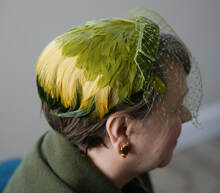 After wearing some easy wool hats, I decided to tackle wearing a hat I’d never worn before—this green feathered hat. I bought it years ago in a consignment store. At the time, I had a vision of finding the perfect vintage dress to go with it, and perhaps wearing it on Halloween, as I did my first hat. I put the hat in the box and went hunting through vintage clothing stores. I never found a dress that I thought would match the hat, which was probably a good thing, because in my mind, this hat was wild, bright lime green and neon yellow. So I was surprised, years later, when I looked at the hat again and found it (especially the velvet bow in the front) more olive than lime. I’d had an olive jacket in my closet the whole time. I not only lacked a matching dress, I also lacked the courage to wear this hat. For a long time, I only wore the hats I bought new, because I was afraid I would look ridiculous in the vintage hats. Even when I started wearing a few of my vintage hats, they tended to be small black or brown ones. It took courage for me to walk into church wearing parrot plumage on my head. And one person did (with a smile) call me Birdie. But many people also told me how much they enjoyed my hats—and this hat in particular. It made me realize that the vintage hat did make me look ridiculous, but only because it took me a ridiculously long time to wear it. Front and back views
|
AuthorAnn Hillesland writes fiction and nonfiction and collects hats. In this blog she vows to wear (not just model, but wear out of the house) every one of her hats, blogging about their histories and their meanings for her. Archives
March 2024
Categories |


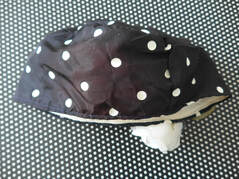
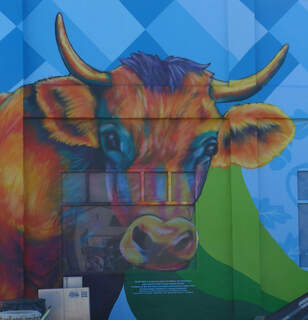
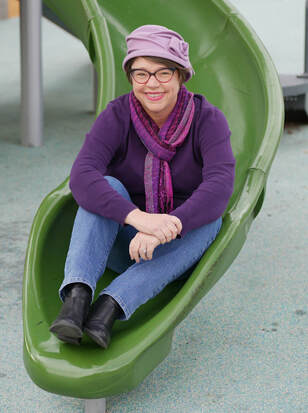
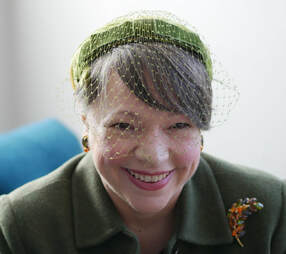
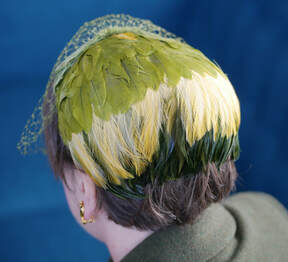
 RSS Feed
RSS Feed